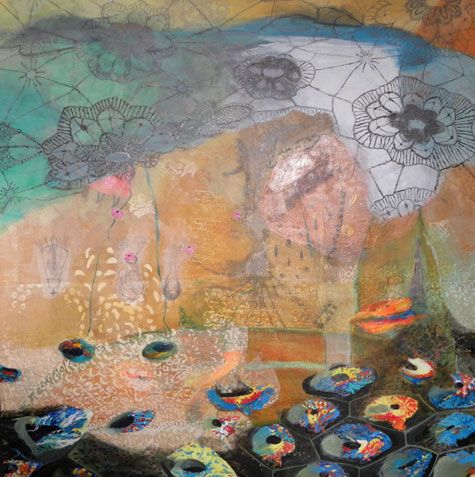
A HOTHOUSE PLANET? Bruton’s The Healing Source. |
For decades, abstraction dominated avant-garde discourse, as painters worked to break art down to its basic elements, stripping away more and more of what seemed necessary to a painting, and then stripping away even more. The all-white paintings and giant steel cubes of the height of 1960s Minimalism signaled a turning point, however. Abstraction continues to dominate sculpture — particularly friendlier, warmer iterations of Minimalism — and major abstract painting continues to be produced by artists from Brice Marden to Elizabeth Murray to Gerhard Richter. But the style has become increasingly pushed out of the spotlight by various flavors of eccentric realism. Once painters split the atom, the experiments that helped them get there just didn’t feel so vital any more.
Yet right on the heels of the excellent Pat Steir abstract drawing retrospective opening at the RISD Museum, the exhibit “Abstraction in Providence” arrives at Rhode Island College’s Bannister Gallery (600 Mount Pleasant Avenue, Providence, through April 22). Director James Montford rounds up five Providence painters for a strong mini-survey that leans toward the brushy, the romantic, the idiosyncratic personal touch.
Lloyd Martin is the only one of the bunch whose work is based on hard-edged geometry — but even that seems to be rusting away. His paintings are inspired rundown mills, patchwork loading docks, and tired, weathered walls. The star of the show is Martin’s Currant (2009), which features three abutting vertical canvases divided by horizontal stripes. The predominant hue is a pale blue painted over a rusty orange ground, the contrast between the color opposites upping the wattage of each other. There are also some narrower orange, black, red, and yellow stripes, as well as white blocks, and drips and splatters and things painted out. They channel the charismatic nostalgia of urban decay.
Irene Lawrence builds her compositions with lots of hesitant, scrubbed in brushstrokes. They form hazy patterns of hovering dashes that occasionally coalesce into something resembling Holstein cattle markings. She drags black shuffling marks, in no obvious pattern, across a gray-black field in Eros Negri/2 (2010). Her brushstrokes feel a bit like Monet’s in his late mural-sized water lily paintings, but with a simplified palette, narrower range of effects, and more somber mood.
Ruth Dealy outlines her self-portraits with big flat-footed black strokes across paint-spattered backgrounds. The compositions don’t come together, but perhaps that’s the point. It’s as if she’s staring at herself age, while losing the crispness of her eyesight, and so feeling out each new wrinkle.
Montford includes a handful of painted assemblages by Mahler Ryder, a RISD illustration teacher and co-founder of the Studio Museum in Harlem, New York, who died of cancer at age 54 in 1992. Some seem like knockoffs of early Cubist sculptures of violins or guitars. In general, these paintings haven’t aged well, suffering from being inclusive to the point of distraction — too many colors, too many shapes, too many croquet mallets and balls (for real).
Donna Bruton plays along this same edge. The Healing Source features a network of black outlined lacy flowers across a field of turquoise at top, with plantlike forms sketched across a gold background in the middle, and what might be rainbow water lilies on geodesic domes at bottom. It’s like a glimpse of some other hothouse planet. Except for those rainbow hues — which overwhelm the other ingredients — she gets the bright colors to compliment each other by teasing out their harmonies.
In the end, “Abstraction in Providence” settles for being a loose collection of artists, a kind of fun party with memorable guests. But Montford doesn’t attempt to draw connections or assess just what’s going on in abstraction in Providence. What would have happened if these mostly middle-aged painters were joined by younger locals — like Jessica Ciocci’s Technicolor pixel drawings, Neal Walsh’s old-building-like paintings, Alison Owen’s hand-drawn wallpaper installations, Elizabeth Duffy’s drawings of the patterns from the inside of security envelopes, or Xander Marro’s quilts? Then add in the late Aaron Siskind’s abstract photos from Providence in the 1970s.
Siskind became one of the greatest artists of the past century by turning photographs into Franz Kline-like abstractions by focusing closely on paint splatters and ripped posters on old outdoor walls. Perhaps what connects these Rhode Islanders is their engagement with the world — rundown buildings, wallpaper, and fabric patterns, their face in the mirror, digital static — as a source for their abstraction.
Read Greg Cook’s blog at gregcookland.com/journal.